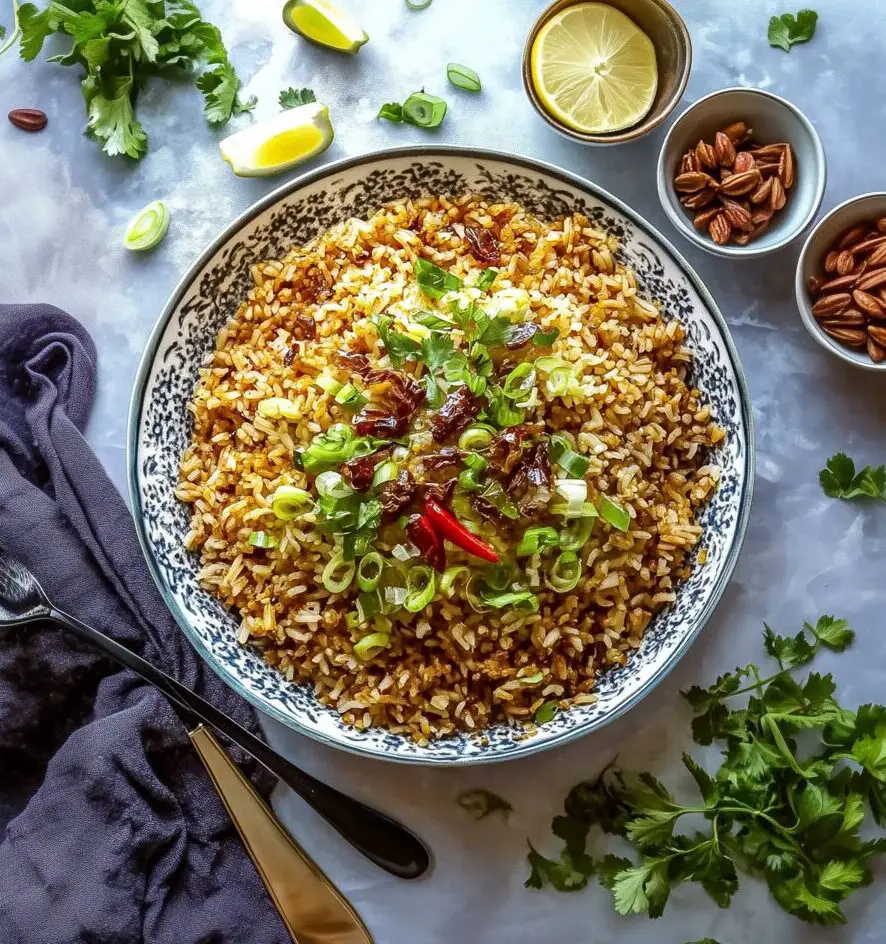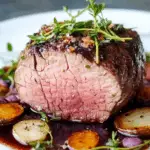Mujadara is a comforting and delicious lentil and rice dish from the Middle East. It features boiled lentils and rice flavored with warm spices, caramelized onions, and fresh herbs. This dish is easy to make with simple ingredients, packed with flavor, nourishing, and satisfying.
Full Recipe:
Ingredients
- 1 cup dried green or brown lentils
- ½ cup basmati rice
- 2 large onions, sliced
- 2 tablespoons olive oil
- 1 teaspoon sugar
- 1 tablespoon vinegar
- 1 teaspoon salt (plus more to taste)
- Water (for boiling)
- Spices: coriander, paprika, cumin, cinnamon, red pepper flakes, turmeric
- 2 cloves garlic, pressed
- 2 scallions, chopped
- Fresh parsley and cilantro (optional)
- Lemon juice (optional)
Directions
- Caramelize the onions: Peel and slice the onions into ½ cm slices. Sauté them with olive oil, salt, and sugar in a large skillet over medium heat for 5 minutes, stirring often. Add water, lower the heat to medium-low, and simmer for 20 minutes until the liquid evaporates and the onions are golden and soft. Increase the heat to high, add vinegar, stir for 2 minutes, then turn off the heat and set aside.
- Cook the lentils: In a pot, bring 4 cups of water to a boil. Add rinsed lentils and 1 teaspoon of salt. Simmer for 15 to 30 minutes until tender but still holding their shape. Drain and set aside.
- Cook the rice: In another pot, bring 3 cups of water to a boil. Add rinsed basmati rice and ½ teaspoon of salt. Boil on low heat for 8 to 10 minutes until cooked but with a bite. Drain and set aside.
- Combine and season: Heat olive oil in a large skillet. Add chopped scallions (reserve tops for garnish) and sauté for 2 minutes. Add pressed garlic, red pepper flakes, ground cumin, ground coriander, cinnamon, paprika, and turmeric. Stir for 1 minute until fragrant. Add the cooked lentils and rice to the skillet, mixing well to combine with the spices. Adjust salt to taste.
- Serve: Top the mujadara with the caramelized onions and garnish with chopped parsley, cilantro, and scallion tops. Drizzle with lemon juice if desired.
Nutritional Facts
Per serving (approximately 1 cup):
- Calories: 350
- Protein: 20g
- Carbohydrates: 50g
- Dietary Fiber: 15g
- Fat: 10g
- Saturated Fat: 1.5g
- Sodium: 400mg
- Iron: 4mg
- Calcium: 60mg
- Vitamin C: 10mg
The History and Origins of Mujadara
Mujadara has ancient roots, and its history traces back thousands of years. The name “Mujadara” comes from the Arabic word “Jadir,” which means “pockmarked,” likely referring to the appearance of the dish, where the lentils and rice are dotted with golden caramelized onions. Some historians suggest that this dish may have been made in the early days of agriculture, as lentils were one of the first crops to be domesticated in the Middle East.
Health Benefits of Mujadara
Mujadara is not only delicious but also highly nutritious. As a plant-based dish, it provides numerous health benefits, making it an excellent choice for those looking to incorporate more legumes and whole grains into their diets.
-
Rich in Protein: Lentils are an excellent source of plant-based protein, and when combined with rice, they form a complete protein, making mujadara a great option for vegetarians and vegans looking to meet their protein needs. Protein is essential for muscle repair, immune function, and overall health.
-
High in Fiber: Both lentils and rice are rich in fiber, which aids in digestion and promotes gut health. Fiber also helps maintain stable blood sugar levels, making mujadara a good option for those managing diabetes.
-
Packed with Nutrients: Lentils are loaded with essential vitamins and minerals, including iron, folate, and magnesium. These nutrients are vital for maintaining energy levels, healthy blood circulation, and bone health. The caramelized onions add an extra layer of antioxidants, which can help protect the body from oxidative stress and inflammation.
-
Low in Fat: The dish is naturally low in fat, and with the use of olive oil for cooking, it provides heart-healthy monounsaturated fats. This makes mujadara a good option for those looking to maintain a healthy weight or reduce their risk of cardiovascular diseases.
-
Gluten-Free and Vegan: Since mujadara is made from lentils, rice, and onions, it is naturally gluten-free and vegan, making it a suitable choice for people with gluten sensitivity or those following plant-based diets.
Cultural Significance of Mujadara
Mujadara is more than just a meal; it holds cultural and symbolic significance in many Middle Eastern countries. The dish is often served during religious holidays, gatherings, and celebrations. In Lebanon, for instance, it is a traditional dish served during Lent, as it aligns with the fasting practices of avoiding animal products. It’s also a popular choice during Ramadan, when families break their fast with nutritious and filling dishes.
Variations of Mujadara Across the Region
Mujadara has several variations across different regions, with each country putting its unique spin on the dish based on local preferences and available ingredients. While the core components of lentils, rice, and onions remain consistent, regional differences in spices, cooking methods, and accompanying sides can vary.
-
Lebanese Mujadara: In Lebanon, mujadara is often made with brown or green lentils, long-grain rice, and topped with a generous amount of caramelized onions. The dish is commonly served with a side of yogurt or a simple cucumber and tomato salad.
-
Syrian Mujadara: Syrian mujadara typically uses brown lentils and has a slightly spicier profile, with the addition of cinnamon and allspice. It is also traditionally served with pickled vegetables to complement the dish’s rich flavors.
-
Palestinian Mujadara: Palestinian mujadara is made similarly to Lebanese mujadara but may incorporate a more significant amount of garlic and a touch of cumin. It’s often paired with tahini sauce or yogurt to balance the spices.
-
Jordanian Mujadara: In Jordan, mujadara can be found in both vegetarian and meat-based versions. Some Jordanians will add a bit of ground lamb to the dish, although the classic vegetarian version remains the most popular.
-
Egyptian Mujadara: Egyptian versions of mujadara often include the addition of fava beans or chickpeas, making the dish even heartier. It is typically seasoned with cumin and coriander, giving it a distinct flavor.
Despite the variations, one thing remains constant: the warm, comforting feeling that comes from a plate of mujadara, no matter where it is made.
How to Make Perfect Mujadara
Making the perfect mujadara requires a few key steps to ensure the balance of flavors and textures. Here are some tips for making mujadara that will impress everyone at the table:
-
Use the Right Rice and Lentils: For the best texture, use basmati rice and brown or green lentils. Basmati rice has a fragrant, long grain that pairs well with lentils. Make sure the lentils are tender but not mushy.
-
Caramelize the Onions: The caramelized onions are the star of this dish, so don’t rush this step. Slow-cook them over medium heat until they are deep golden brown, almost melting in texture. This process brings out their natural sweetness and creates a rich depth of flavor.
-
Spice it Right: The spices in mujadara should be used thoughtfully to balance the earthiness of the lentils and the sweetness of the onions. Don’t be afraid to experiment with adding a pinch of cinnamon, cumin, or turmeric for extra flavor.
-
Serve with Accompaniments: While mujadara is delicious on its own, it pairs wonderfully with yogurt, a fresh cucumber salad, or pickled vegetables. A drizzle of tahini can also add a creamy texture and nutty flavor that complements the dish.
-
Make it a Meal: If you’re looking to make mujadara a more substantial meal, you can add a side of grilled vegetables or a protein like falafel. It can also be paired with flatbread for a more filling experience.
Conclusion
Mujadara is a simple yet incredibly satisfying dish that combines the earthiness of lentils, the fragrance of basmati rice, and the sweetness of caramelized onions. With its roots deeply planted in Middle Eastern cuisine, this dish has traveled across countries and generations, evolving along the way while maintaining its status as a comfort food. Whether you’re following a vegan diet, looking for a gluten-free meal, or simply craving something wholesome and flavorful, mujadara delivers on all fronts. Its nutritional benefits, ease of preparation, and cultural significance make it a perfect addition to any meal plan.






